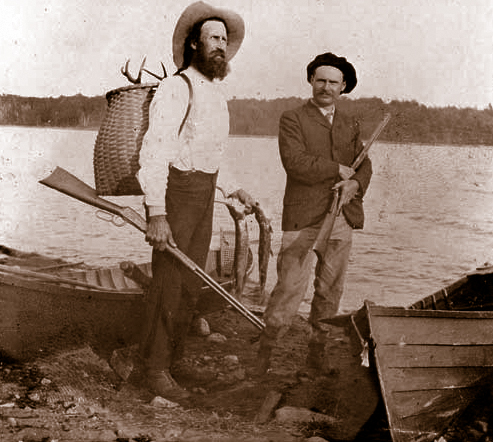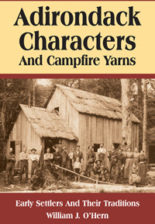Adirondack Characters Introduction: When I was a boy I would listen in awe to the stories of exploration told by avid fishermen and hunters.

Adirondack Characters And Campfire Yarns
Introduction
An excerpt from ” Adirondack Characters And Campfire Yarns “, Starting on page 9
WHEN I WAS A BOY I would listen in awe to the stories of exploration told by avid fishermen, hunters, and mountain climbers who stopped by as they passed from Seventh to Eighth Lake on their return from some deep woods haunt, to share their experience at my parents’ tent site at Eighth Lake campground.
Grandpa managed the Potter Boat Company, a sales and repair shop that sold Evinrude outboard motors, boats, and accessories. In those days business was relaxed. Customers stopped by the shop to talk before and after trips to the lower lake country. Sportsmen and recreationalists, whether campground passersby or customers, were easygoing, friendly folks who offered tidbits of their adventures afoot in the Adirondacks. Some were natives who worked the land with horse teams. Others had ancestors who had cut down trees and built log cabins. One man had been given a contract to cut the timber on hundreds of acres of land; he was to have as half-payment a portion of the acreage after the timber was cut. Others worked on crews that cut out improved roads and built bridges. Those who talked about trapping in the mountains, hunting black bear, boating and fishing the big waters, and bushwhacking to reach the summits of trail-less peaks were intriguing storytellers. The men who rode rolling logs and broke up jams seemed to tell the most exciting and dangerous tales. How could I not want to join the river drivers who broke log jams to send rolling, tumbling, masses of logs rushing down river with several men riding along? They had to jump from log to log until they could reach the riverbank or a boat. Sometimes a man would slip, be carried under and lost forever.
As a result of my exposure to mountain life, I couldn’t wait to grow up: I wanted to see the wilderness. I wanted to go beyond the beaten path with only the supplies I could carry in a packbasket.
A large portion of my summers was spent living at Camp Oasis, my maternal grandparents’ riverfront camp. They knew how to make do on their own. They raised most of their own vegetables, fruits, and meat. Gardening was second nature. I remember gathering eggs in the A-frame hen house and learning the lessons of life and death at the chopping block. Root cellars were as ordinary as the coal bin and the stacks of cordwood. Blocks of ice were bought to keep perishable foods cool. Few grandparents today would give their young grandson a hatchet, even with proper instruction. I enjoyed the grown-up feeling gained from being trusted to take billets of wood and split them into the proper size for the wood-fired kitchen range. Responsibility came early in a child’s life.
One of the most important qualities Grandma and Grandpa had was self-sufficiency. Their conviction was passed on to me.
When I was about twelve years of age I began picking baskets of raspberries. Heritage red raspberries are everbearing; they provide a good yield over a long period of time. I marketed them at a roadside stand, along with angle worms raised in our camp’s garbage pit. I earned twenty-five cents a quart for red raspberries. One well-heeled gentleman asked me to keep his family supplied with berries. At the end of several weeks I handed him twenty one-quart baskets of berries at twenty-five cents a quart.
“Great Scott!” he exclaimed, “I made my money by hard work, and as a boy, I would have been glad to get five cents a basket for berries. It seems to me the price has gone up.”
“Yes,” I replied, fully aware of my toil. I had helped string and tighten the wire between the poles, trained bramble canes over wire supports, kept the berry patch weeded, and mowed between the rows with a heavy iron-wheeled push mower. “The price has gone up,” I explained, “but the berries are cultivated and require more work.”
There was little disposable income for what folks might refer to as fun today. Rural children of my generation knew how to entertain themselves the way modern children can’t, or won’t. The simplest things were big deals. Being outside was important: investigating the riverbank, building huts in the woods, roaming cow pastures, and playing made-up games. I can remember being near the big box Zenith radio listening to “Gunsmoke” and “The Lone Ranger.” I would lie on the camp’s sheepskin rug on the floor in front of the cobblestone fireplace. I would be perfectly silent one minute and shouting the next as the broadcast sound effect of a galloping horse or squeaking saloon door came over the airwaves. I took it seriously, becoming so wrapped up in the story that I thought it was true. Then I would go to bed, afraid to close my eyes because a villain might find his way to our camp.
I was no less absorbed when a hunter dragged the carcass of an enormous black bear or whitetail buck from a pickup through the front door of the meat market.
“Where did you get the big brute?” I might have inquired.
“We shot him in the wilds around Hoffmeister up in the West Canada Crick country,” might have been the reply. “We’ve got ourselves a huntin’ camp up that way. Built it from an old barracks we bought from the government after the air base closed.”
“Be jagers!” I thought. A hunting camp! Wilderness! Wild animals! Names of far-away places in the Adirondack Mountains. I was intrigued.
My youthful imagination was a rich source of entertainment. As a result of my interest in listening to the stories of men and women who visited and lived in the mountains, I developed an insatiable thirst to experience the pleasures of exploring the Adirondacks. I’ve logged almost sixty years of pleasure in “God’s country” now, and I’m still counting.
Today the North Woods provide a totally different experience from the Adirondacks of my youth. The aged folks I knew in those days knew an even more profoundly different North Country. Those who went deep into the woodlands found land to range and privacy far back from the newly constructed highways that brought rushing crowds of motorists.
Enter Lloyd Blankman. He was a senior gentleman in my youth. Like my parents and grandparents, he knew from firsthand experience that family and community were the most important things to rural folks during and after the Great Depression. Nothing was closer than blood, followed by community spirit. And nothing brought people closer together than going through hard times.

As a boy, Lloyd Blankman knew the dread of entering the “little house out back” in winter, the blisters earned working a buck-saw or a hand hoe. He knew the smell from a village drug store where the pharmacist ground his ingredients, and the care needed by a tired boy following the evening milking as he carried pails of milk from the barn to the cool farm cellar. He seldom slipped into store-brought clothes. Patched-up hand-me-downs made up the bulk of a child’s wardrobe.
Lloyd Blankman also loved the same region around the Adirondack headwaters in which I have spent so many years knocking around. His avocation in old age was to ferret out the history of the natives who lived in the south- western Adirondacks. Whatever sporting he enjoyed in his life always led him back to the native Adirondackers in the lower mountains. Nestled in those headwaters, he found the rich folklore that he decided to record.
Over a span of twelve years Lloyd Blankman talked with dozens of family members of mountain residents. He personally interviewed notable old-timers who held that they had many advantages in the “old days” that their kin are deprived of now-abundant wild meat, economic opportunities, and freedom from government overregulation. Most folks had plenty to eat and wear but, whipped by the Depression, had no money. They learned to get by the hard way-not because they viewed experience as being the best teacher, but because they couldn’t find or afford any other way. Blankman, as an interviewer, understood how the older generation felt. It was his wish to record for future generations what rested within the memory of men and women living in his beloved Adirondacks. He gathered their stories and began presenting them in his weekly newspaper column, “Adirondack Characters.” The setting is Herkimer County, in the southwestern corner of the “blue line” that outlines the Adirondack Park, in the middle of the twentieth century.
These are the stories of those Adirondack characters.